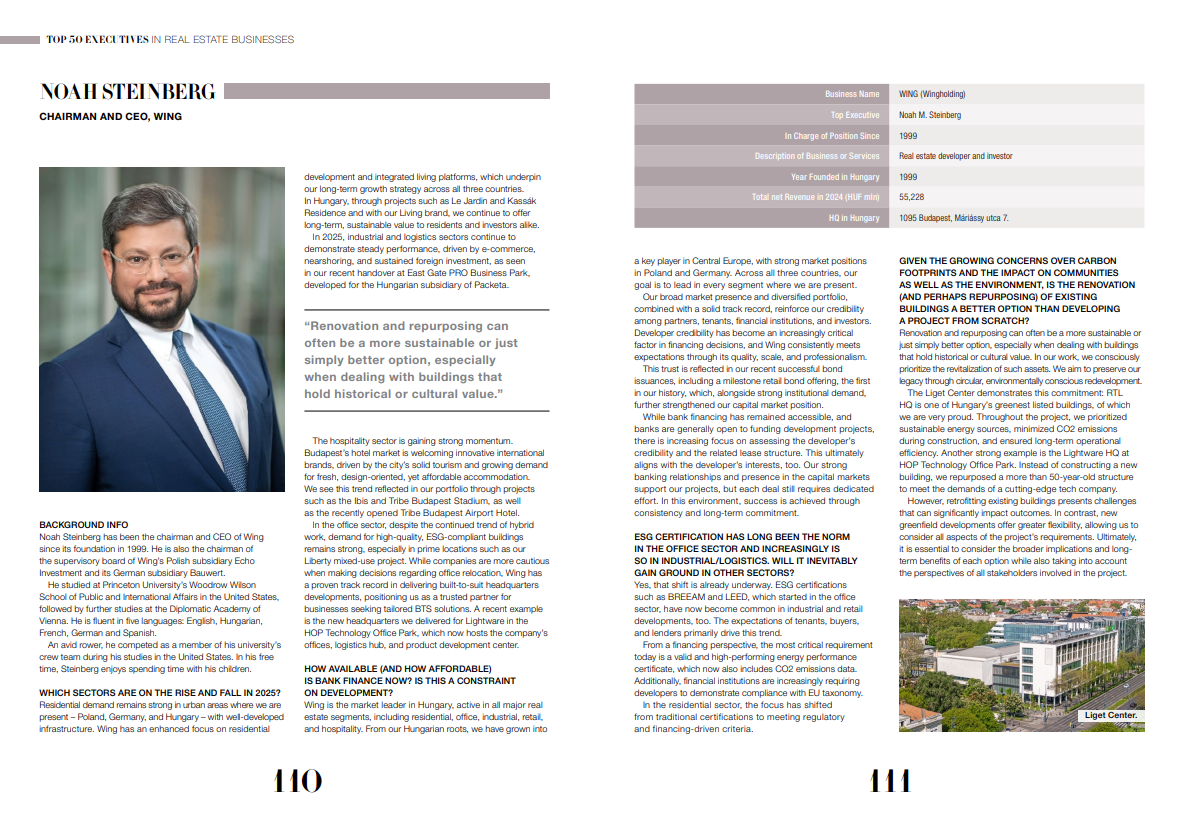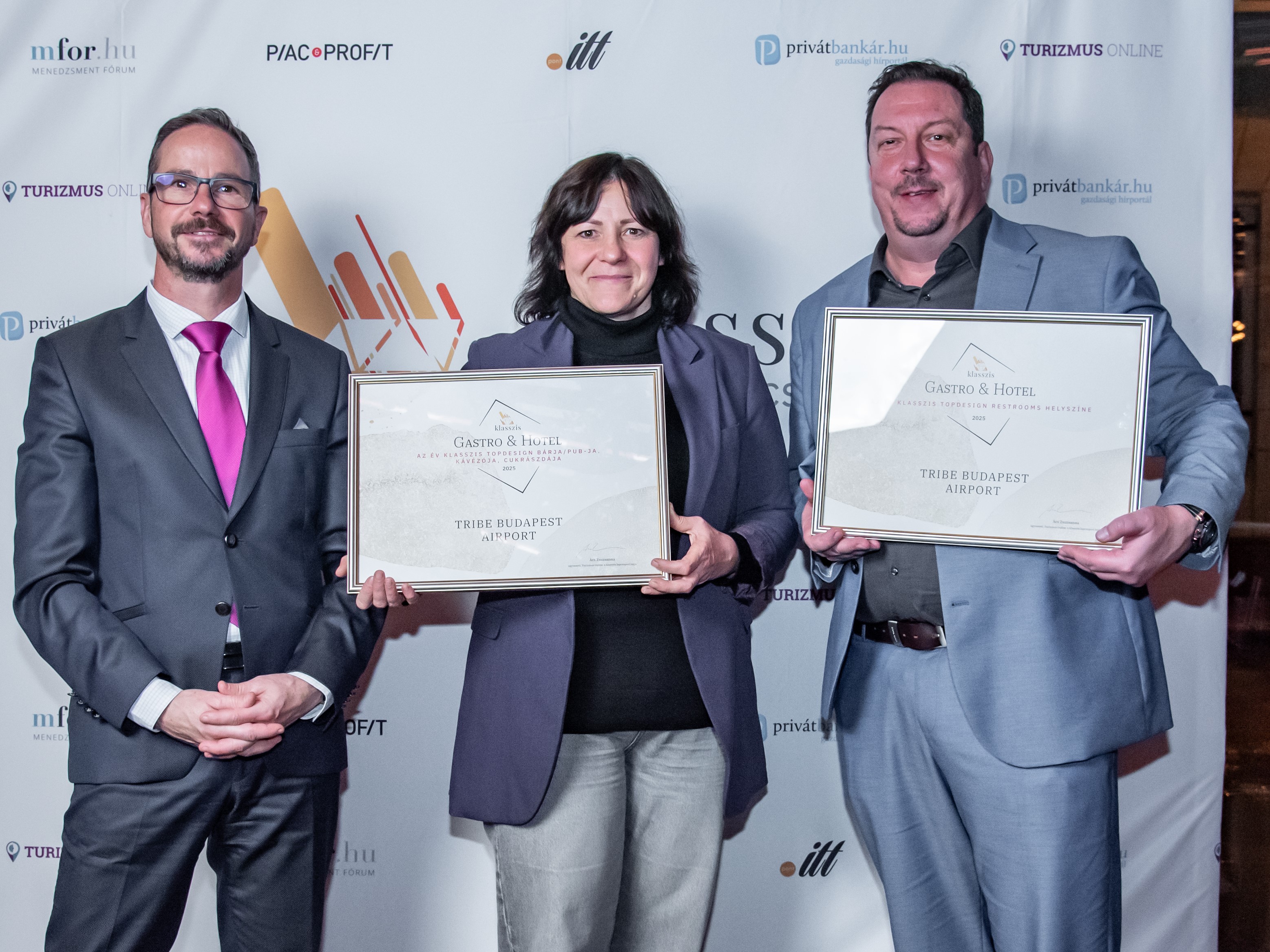Noah Steinberg - Top 50 Executives in Real Estate Businesses 2025
2025-07-08
Noah Steinberg, Chairman and CEO of WING, has been included in the 2025 Top 50 Real Estate Executives list in Hungary. The Top 50 Real Estate Executives is an annual special publication by the BBJ Budapest Business Journal that profiles the most influential real estate leaders working in the Hungarian economy.
BACKGROUND INFO
Noah Steinberg has been Chairman and CEO of Wing since its foundation in 1999. He is also the Chairman of the Supervisory Board of Wing’s Polish subsidiary Echo Investment and German subsidiary Bauwert. He studied at Princeton University’s Woodrow Wilson School of Public and International Affairs in the United States, followed by further studies at the Diplomatic Academy of Vienna. He is fluent in five languages: English, Hungarian, French, German and Spanish. An avid rower, he competed as a member of his university’s crew team during his studies in the States. In his free time, Steinberg enjoys spending time with his children.
Which sectors (office, retail, etc.) are on the rise and fall in 2025?
Residential demand remains strong in urban areas where we are present – Poland, Germany, and Hungary – with well-developed infrastructure. WING has an enhanced focus on residential development and integrated living platforms, which underpin our long-term growth strategy across all three countries. In Hungary, through projects like Le Jardin and Kassák Residence, and with our LIVING brand, we continue to offer long-term, sustainable value to residents and investors alike.
In 2025 industrial and logistics sectors continue to demonstrate steady performance, driven by e-commerce, nearshoring, and sustained foreign investment - as seen in our recent handover at East Gate PRO Business Park, developed for the Hungarian subsidiary of Packeta.
In 2025, the hospitality sector is gaining strong momentum. Budapest’s hotel market is welcoming innovative international brands, driven by the city's solid tourism and a growing demand for fresh, design-oriented yet affordable accommodation. At WING, we see this trend reflected in our portfolio trough projects such as the ibis & TRIBE Budapest Stadium and the recently opened TRIBE Budapest Airport Hotel.
In the office sector, despite the continued trend of hybrid work, demand for high-quality, ESG-compliant buildings remains strong, especially in prime locations such as our Liberty mixed-use project. While companies are more cautious when making decisions regarding office relocation, WING has a proven track record in delivering built-to-suit headquarter developments, positioning us as a trusted partner for businesses seeking tailored, built-to-suit solutions. A recent example is the new headquarters we delivered for Lightware in the HOP Technology Office Park, which now hosts the company’s offices, logistics hub, and product development center.
How available (and how affordable) is bank finance now? Is this a constraint on development?
WING is the market leader in Hungary, active in all real estate segments—residential, office, industrial, retail, and hospitality. From its Hungarian roots, WING has grown into a key player in Central Europe, with strong market positions in Poland and Germany. Across all three countries, our goal is to lead in every segment where we are present.
Our broad market presence and diversified portfolio, combined with solid track record reinforce WING’s credibility - from partners and tenants to financial institutions and investors. Developer credibility becomes an increasingly critical factor in financing decisions, and WING consistently meets expectations through quality, scale, and professionalism.
This trust is reflected in our recent successful bond issuances, including a milestone retail bond offering—the first in our history—which, alongside strong institutional demand, further strengthened our capital market position.
While bank financing has remained accessible, and banks are generally open to funding development projects. However, there is now increasing focus on assessing the developer’s credibility and the related lease structure. This ultimately aligns with developers’ own interests too. Our strong banking relationships and presence in the capital markets support our projects, but each deal still requires dedicated effort. In this environment, success is achieved through consistency and long-term commitment.
ESG certification has long been the norm in the office sector and increasingly is so in industrial/logistics. Will it inevitably gain ground in other sectors?
Yes, that shift is already underway. ESG certifications such as BREEAM and LEED, which started in the office sector, have now become common in industrial and retail developments too. This trend is primarily driven by tenant, buyer, and lender expectations.
From a financing perspective, the most critical requirement today is a valid and high-performing energy performance certificate (EPC), which now also includes CO₂ emissions data. Additionally, financial institutions are increasingly requiring developers to demonstrate compliance with the EU Taxonomy.
In the residential sector, the focus has shifted from traditional certifications and more about meeting these regulatory and financing-driven criteria.
Given the growing concerns over carbon footprints and the impact on communities as well as the environment, is the renovation (and perhaps repurposing) of existing buildings a better option than developing a project from scratch?
Renovation and repurposing can often be a more sustainable or just simply better option, especially when dealing with buildings that hold historical or cultural value. In our work, we consciously prioritize the revitalization of such assets. We aim to preserve our legacy through circular, environmentally conscious redevelopment.
The Liget Center demonstrates this commitment: RTL HQ is one of Hungary’s greenest listed buildings, of which we are very proud. Throughout the project, we prioritized sustainable energy sources, minimized CO₂ emissions during construction, and ensured long-term operational efficiency. Another strong example is Lightware’s new headquarters at HOP Technology Office Park. Instead of constructing a new building, we repurposed a more than 50-year-old structure to meet the demands of a cutting-edge tech company.
However, retrofitting existing buildings comes with challenges that can have significant impact on outcomes. In contrast, new greenfield developments offer greater flexibility, allowing us to consider all aspects of the project’s requirements. Ultimately, it is essential to consider the broader implications and long-term benefits of each option, while also taking into account the perspectives of all stakeholders involved in the project.
To buy the magazine click on the link below:
Top 50 Real Estate Businesses Executives 2025 - BBJ






